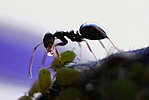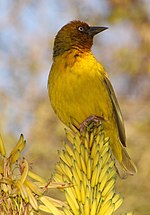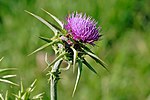Hummingbird (section Perception of sweet nectar)
Noted for long beaks, hummingbirds are specialized for feeding on flower nectar, but all species also consume small insects. They are known as hummingbirds...
165 KB (17,671 words) - 15:28, 30 October 2024
Ambrosia (redirect from Nectar of the gods)
other form of sustenance, nectar. The two terms may not have originally been distinguished; though in Homer's poems nectar is usually the drink and ambrosia...
12 KB (1,497 words) - 00:50, 29 October 2024
Nectar guides are markings or patterns seen in flowers of some angiosperm species, that guide pollinators to their rewards. Rewards commonly take the form...
4 KB (426 words) - 19:50, 27 March 2023
feed on nectar, using their long hairy tongues to lap up the liquid; the proboscis is folded under the head during flight. Bumblebees gather nectar to add...
108 KB (11,622 words) - 18:02, 23 October 2024
adapted to gathering pollen and nectar from flowers. Nectar from eucalyptus is important in Australia, other important nectar sources are Pittosporum, Grevillea...
22 KB (2,257 words) - 20:41, 18 August 2024
gathering and then refining the sugary secretions of plants (primarily floral nectar) or the secretions of other insects, like the honeydew of aphids. This refinement...
124 KB (13,363 words) - 08:16, 18 October 2024
Honeydew (secretion) (section Nectar producing trees)
both the honeydew nectar and manna tends to increase in spring and autumn. Eucalyptus can produce even more manna than honeydew nectar. The sugar glider...
14 KB (1,485 words) - 02:15, 28 October 2024
nectar, eat not the food of mortals, but ambrosia; thence it is that they are bloodless and exempt from death. — W. Cowper, citing a remark by J. de Villoison...
6 KB (670 words) - 14:06, 11 August 2024
Bat (section Fruit and nectar)
insectivores, and most of the rest are frugivores (fruit-eaters) or nectarivores (nectar-eaters). A few species feed on animals other than insects; for example,...
171 KB (18,305 words) - 15:24, 31 October 2024
characterized by their specialized brush-tipped tongues for feeding on nectar of various blossoms and soft fruits, preferably berries. The species form...
21 KB (1,380 words) - 09:04, 24 September 2024
brightly colored, conspicuous petals, attractive scents, and the production of nectar, a food source for pollinators. In this way, many flowering plants have...
103 KB (11,623 words) - 21:38, 26 September 2024
Euphorbia (category CS1 German-language sources (de))
have sepals, petals, or nectar to attract pollinators, although other nonflower parts of the plant have an appearance and nectar glands with similar roles...
37 KB (3,462 words) - 05:20, 5 August 2024
spiders, seeds, nectar, and fruit. The females appear to enjoy a more varied diet than the males. Cape weavers are generalist nectar-feeders and in South...
10 KB (1,254 words) - 10:23, 4 October 2024
pollinating them as it hovers to sip their nectar. In its native Ecuador, the plant has the Spanish common names flor de quinde ('hummingbird flower'), flor...
22 KB (2,633 words) - 03:49, 17 August 2024
of 43.3% gum, 31.7% nectar, 22.5% fruit, and just 2.5% arthropods and other animal prey. The most common dietary item was nectar from flowers of the Bertram...
105 KB (10,462 words) - 12:49, 29 October 2024
no nectar. Their scent tricks sphinx moths into pollinating them by transferring pollen from flower to flower in their fruitless search for nectar. Insects...
24 KB (2,285 words) - 16:11, 16 October 2024
this lifestyle. Both hummingbirds and perching birds visit the flowers for nectar. The black metaltail hummingbird (Metallura phoebe) lives in the stands...
18 KB (1,852 words) - 06:20, 3 October 2024
more delicate in structure, and attracts pollinators by colour, scent, and nectar. Most flowers are hermaphroditic, producing both pollen and ovules in the...
79 KB (6,316 words) - 21:29, 28 October 2024
appreciated worldwide as ornamentals and for the value of their flowers as a nectar source for many species of butterfly. However, the plant does not provide...
66 KB (4,893 words) - 21:04, 28 July 2024
Vanuatu (redirect from République de Vanuatu)
pollinate and disperse seed from a variety of native trees. Their diet is nectar, pollen and fruit and they are commonly called "fruit bats". They are in...
157 KB (14,877 words) - 15:21, 22 October 2024
whose females can attain a length of 39 millimetres (1.54 in). Bees feed on nectar and pollen, the former primarily as an energy source and the latter primarily...
119 KB (12,339 words) - 14:29, 29 October 2024
helps the animal to obtain fruit and to lick nectar from flowers, so it sometimes acts as a pollinator. (Nectar is also sometimes obtained by eating entire...
26 KB (2,710 words) - 02:34, 23 October 2024
Kākā (section Honeydew and Nectar-feeding)
feeds on nectar, and it uses its strong beak to dig out the grubs of the huhu beetle and to remove bark to feed on sap. They consume nectar from plant...
46 KB (5,213 words) - 03:45, 11 October 2024
a core of indigestible black seeds. The pulp is also used to make fruit nectar, smoothies, fruit juice drinks, as well as candies, sorbets, and ice cream...
20 KB (2,362 words) - 23:56, 31 October 2024
Gins Bull Terrier" (in Spanish). Retrieved 12 October 2022. "Hierbas - Nectar of the Gods". Affordable Mallorca. Retrieved 12 October 2022. "Hierbas"...
4 KB (361 words) - 15:34, 25 October 2024
Mosquito (category CS1 German-language sources (de))
specialized, highly elongated, piercing-sucking mouthparts. All mosquitoes drink nectar from flowers; females of some species have in addition adapted to drink...
93 KB (9,237 words) - 14:56, 10 October 2024
leaves have a mild lemon scent. During summer, small white flowers full of nectar appear. It is not to be confused with bee balm (genus Monarda), although...
17 KB (1,695 words) - 21:27, 27 October 2024
particularly valued by bumblebees for their high nectar production. Cirsium vulgare was ranked in the top ten for nectar production in a UK plants survey conducted...
27 KB (2,882 words) - 03:14, 6 August 2024
Time perception (category CS1 German-language sources (de))
When returning to the hive with nectar, forager honey bees need to know the current ratio of nectar-collecting to nectar-processing rates in the colony...
85 KB (10,038 words) - 19:48, 12 September 2024
order to test their omniscience, as well as stealing some ambrosia and nectar. Tantalus is then banished to the underworld, where he stands in a pool...
43 KB (4,526 words) - 22:12, 26 October 2024




























